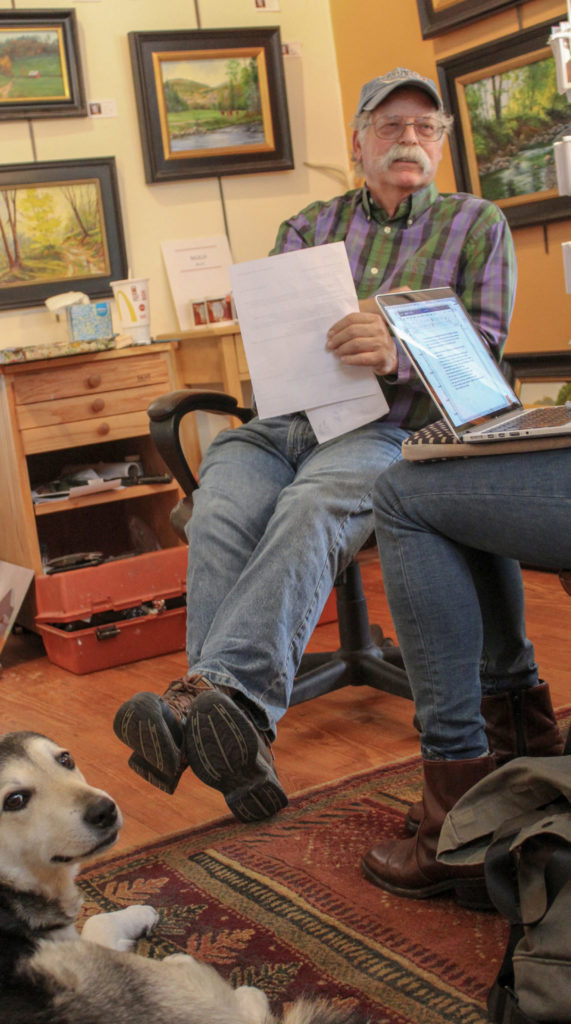
19 Jul What it takes
How do you become a successful artist? Don’t rely on luck.
Successful artists can transform raw materials into something beautiful with ease, find inspiration in the most ordinary places and create works that move us to pay up. They are so lucky, right? It’s a fanciful idea, but luck has very little to do with an artist’s success.
Artist Kenna Al-Sayed’s customers often commission her for custom portraits of horses, a niche market that didn’t just fall into her lap. At first, she sought out her audience at any event that would draw a horse-friendly crowd and entered art auctions to sell her graphite and colored pencil drawings.
“After slowly building up what I thought was a well-rounded CV, I started exhibiting internationally at horse events that had sections devoted to art,” she says. “Social media has also played a large part in connecting myself to an audience for my work. This has, and will continue, to be an ongoing process as artists can rarely rest on their laurels when it comes to promoting their work.”
Artists can rarely rest on their laurels when it comes to promoting their work.
Kenna Al-Sayed
Al-Sayed’s targeted audience, marketing and perseverance are paying off. Her devoted customers reserve 60 percent of her works before the art even arrives to the gallery that represents her. She can vend events halfway around the world and find people who have been following her on social media and have specifically shown up to purchase works or commission her for a portrait.
While chance and good timing play minor roles in finding business success, there is no magic formula to succeed as a professional artist. Al-Sayed’s path certainly could not be replicated for a potter specializing in delicate serving pieces or a metal artist creating large-scale pieces for commercial use. But her drive and business savvy are, arguably, critical to most professional artists’ careers.
Noblesville Creates studio artist Rodney Reveal’s success as an artist can be counted by the awards he’s won over the years, including recognition in the Oil Painters of America Salon Show, American Artist Watercolor Magazine International Competition and Paint the Parks national show. Reveal’s works have been featured in about 20 national shows.

He hasn’t been without fortuitous turns along the way. With the help of adults who believed in him, as a high-schooler he was able to attend an art summer camp at the University of Kansas. Reveal and Bruce Neckar, another professional local artist who was in his same class, won Scholastic Art Awards at the national level. Reveal won a scholarship to the California College of Arts, where he attended for two years before the money ran out, and then came back home to study at Indianapolis’ John Herron School of Art.
Just shy of graduation — blame his aversion to art history — he began a 30-year career with the Noblesville Fire Department. Toward the end of his time as firefighter, he decided to take his art more seriously.
He has learned some hard, valuable lessons along the way to building his career. Collectors value award-winning paintings; they are regarded as smart investments. Getting shut out from a show or failing to win an award can hurt, but it’s healthy.
“Some people don’t do well with being rejected, so they don’t enter, but I always told students and other people, it builds character. After a while you might have so much character you might not want anymore,” Reveal says. “Normally when I get rejected from something that I feel that I should have been in, it makes me mad, and I want to do better. I want I go in to prove them wrong. It makes me work harder.”
Being rejected … builds character. After a while, you might have so much character you might not want anymore.
Rodney Reveal
In a business where a buyer typically responds to their purchase in an emotional way, personal brand matters. Reveal wears an easy smile, a shaggy gray mustache and a ballcap. His dog Thunder sits underfoot. Reveal’s look and demeanor — thoroughly down to earth and friendly — is real, but it’s also part of his brand. He read marketing books when he first started his career to learn the nuances of art sales. Only about half a percent of self-proclaimed artists make a living selling their art. He knew he needed to do it right, and business classes weren’t included in his art school curriculum.
“Most of your successful artists are marketing on their own or have someone else doing it, and doing it very well. One thing I’ve learned is you have to be persistent to get into galleries,” he says.
Another business tactic Reveal says is necessary is consistent communication. When he meets someone interested in his art, he gets their contact information to stay in touch. He sends thank you notes to buyers to keep them engaged. One marketing resource suggested that artists have to connect with an individual 13 times — emails, text, phone call, etc. — before they will make a purchase.
Of course, you have to get comfortable talking about money and fairly pricing your work. And while you want to produce enough art to make a living, scarcity can drive up the value of your art.
A niche that Reveal has tapped into rather by accident is people who love nostalgia. His “hometown series” features historic and older Noblesville-area buildings and scenery, which have been good sellers. He also makes prints, postcards and mugs featuring some of his more popular paintings as a secondary revenue stream.
Reveal also makes sure people are able to see his work. “You can’t sell paintings if they’re under your bed, you know. You have to be visible,” he says. Reveal suggests seeking places to show with natural pedestrian traffic. His studio space inside Noblesville Creates on the first floor of the Stephenson House puts him front and center. “The more visible your studio space is, the more visible your artwork is. But even if you don’t have that, you can be more visible by being in a visible location like a library or restaurant.”
Marketing your work is only useful, of course, if you have high-quality work to sell. And if you talk to artists, luck has little to do with your ability to create something other people are interested in buying. Before he retired from the fire department, Reveal would paint up to 15 paintings a year. Today, he’s finishing 120 or so paintings annually. He had to commit to the work, hunker down and hone his craft.
An important part of Reveal’s process is getting input from his fellow artists at Noblesville Creates. He says they share works in progress with one another to get feedback — move that tree, reconsider that shade of blue, accentuate that corner of sky — to improve, to become better artists as individuals and as a community.
Access to Noblesville Creates also connects Reveal to suppliers for things such as frames or brushes, and the team’s collective skills and knowledge about events and opportunities . “Those things are just absolutely unbelievable,” he says.
Reveal has had some strokes of luck, primarily people who believed in him along the way and encouraged him to study art. But customers, awards and his overall success have been hard earned.
“I’ve had people say, ‘You’re so lucky. How lucky.’ Luck has nothing to do with it. I worked hard at getting out there and getting my name known and doing the work and getting to where I am. There are things that are lucky that you can make happen, but that part isn’t purely luck, is it?”

It’s a lesson some artists are just beginning to learn. Alyssa Sellers is a junior at Herron School of Art and Design at IUPUI majoring in painting with a minor in art history. Between her senior year of high school and college, she took the Monday Night Drawing Class at Noblesville Creates. It wasn’t for academic credit, but Sellers is already taking on hard work to get better, with the hopes of making art a full-time career someday.
“I wanted to challenge myself with something new. I believe that education in the arts is one of the most important things you can do as an artist. It allows you to improve and it really pushes you to do the best work you can. If you surround yourself with people who have the same interests as you, both can learn and grow from each other,” she says.
I believe that education in the arts is one of the most important things you can do as an artist. It allows you to improve and it really pushes you to do the best work you can.
Alyssa Sellers
Through the class, she learned how to communicate with different types of people who are also interested in the arts and showed her work for the first time, getting acclimated to the process of submitting to galleries.
“It made me realize what it was like to actually be a part of a gallery, and I think that played a large role into what I want my future to look like,” she says.
As Sellers continues her education, strengthening her muscles as an artist and a businessperson, Kenna Al-Sayed’s perspective on the idea of “luck” is a valuable — and beautiful — tenet to heed.
“I think luck is inherent with all artists. We must have a work ethic, a drive to create, a passion for perfection; but luck is when our art resonates with other people. You cannot force that, you cannot predict it, and you cannot plan it. It is pure luck to have someone connect with your work. I am lucky that I have year after year found more and more people who connect with my work. I truly hope that luck never runs out,” Al-Sayed says.

